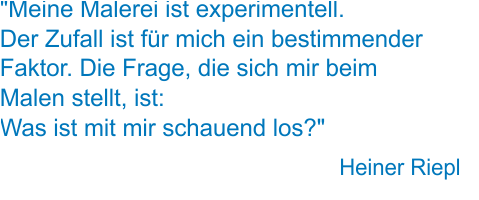Virginia Center for the creative arts
Written by Sarah Sargent, Virginia Center for the Creative Arts, Mai 2015

Working initially as a figurative painter, Heiner has distilled his work down to pure formalism. “If I think about landscape, while working in an abstract manner, I lose my train of thought. You, or more precisely, I, cannot do both. It’s a decision you make to work with forms. You bring special things with you; you don’t have a precise idea of what you want to do, but you know how you want to start. I wanted to start with the colors: red, orange, yellow. This was a feeling.”
Heiner works primarily in oil and because of its drying time, he works on several paintings concurrently. Sometimes he uses rollers and palette knives, in addition to brushes, to apply paint in order to achieve different effects.
Heiner is midway through a month-long residency at VCCA and the paintings in VA9 are in various stages of completion. But according to Heiner: “It takes months and sometimes years until a picture is ready.”
Two works look very different from the rest. In these, amidst the impasto slabs of color are passages featuring decorative flourishes that appear to be printed. They’re actually pieces of wallpaper from a wallpaper sample book that Heiner found in the Studio Barn trash.
Though he won’t say that these two paintings are finished, Heiner says they’re “Okay for me…now.” The wallpaper is attached by tape. He can’t affix it until after the canvas is stretched, which will occur on his return to Germany, but taping it also allows him to tinker with the paintings further, perhaps over painting the wallpaper, or jettisoning it altogether. “Sometimes my paintings change totally from beginning to end,” he allows.
Heiner was the director of Oberpfalzer Künstlerhaus in Schwandorf-Fronberg, Germany from its establishment in 1988 until 2013. The Künstlerhaus, a wonderful example of Bavarian Victorian architecture, was built in the 1880s by the owner of a local ironworks and foundry. He died before occupying the villa and it was sold.
Following the Second World War, the structure was operated by the United States government as a cultural center, primarily showing films. When they left in 1950, the property passed into the hands of the town of Schwandorf-Fronberg. Over the years, the beautiful building fell into disrepair, but was eventually turned once again into a cultural center for exhibitions and concerts. Heiner, well-connected in the art world, was hired to lead the newly formed Oberpfalzer Künstlerhaus.
Quite soon after he took over the helm, a museum director from nearby Regensburg brought then VCCA Executive Director Bill Smart by for a visit. The meeting was a serendipitous one; Bill was due to leave the very next day for home having come to Germany scouting for possible partners to forge an exchange program with VCCA.
Over a cup of coffee at the Künstlerhaus, Heiner and Bill hatched what would become an incredibly vibrant, longstanding exchange program between the two organizations, and which would also lead to partnerships with other international residency programs.
Selling the idea to the local authorities and the surrounding community was challenging. According to Heiner, Bill was invaluable in persuading them of its value, attending a crucial meeting to make the case. Heiner also credits the efforts of VCCA Fellow and current Board Member Pinkney Herbert.
Another key to the success was the establishment of a sponsors’ organization the Förderverein Oberpfalzer Künstlerhaus e.v. that was charged with raising funds to expand and grow the organization. (In addition to owning the original building, the town of Schwandorf-Fronberg picks up the tab for the staff.) In this effort, Heiner relied on the help of VCCA Fellow Peter Meyer (whose charming ceramic horse graces the residence living room and also the website) who was from the area and had a wide circle of contacts.
The original program was bare bones. The Künstlerhaus was turned into temporary studio space and visiting artists were housed in a hotel. Now, there are three buildings comprising studio and residential quarters, the final one completed in 2004. Six artists can be accommodated at one time, generally one composer, one writer and three to four visual artists. They are responsible for their own cooking, but are provided with a per diem to cover food. The program runs from February to December. Shorter sessions featuring master classes and concerts by noted experts also occur during the season.
In 2008, on the 20th anniversary of the partnership, exhibitions in Schwandorf-Fronberg, Regensburg and Amherst featuring the work of artists who had participated in the exchange were organized by Heiner and then VCCA Artistic Director Craig Pleasants.
Many hands have worked to make the exchange program a success. Former VCCA Executive Director Suny Monk and Director of Artists’ Services Sheila GulleyPleasants enthusiastically embraced the program, which flourishes today. Current VCCA Executive Director Gregory Allgire Smith joins in their enthusiasm, counting on the continued partnership between VCCA and the Oberpfalzer Künstlerhaus for many years to come.
In addition to leading the Künstlerhaus for 25 years, Heiner has enjoyed a distinguished career as an artist. His work has been widely exhibited in Germany, Austria, Poland and France including the Ancienne Chapelle du Carmel at Musee des Beaux-Arts de Libourne.
